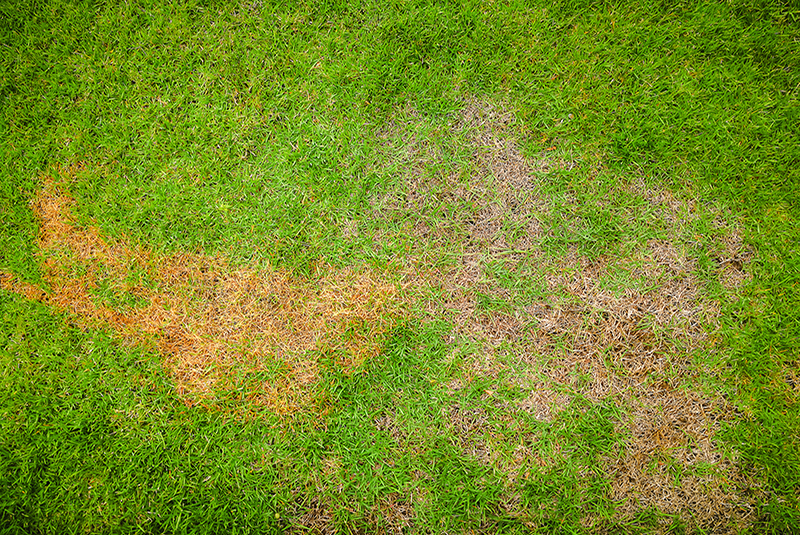This season we have seen excess rain, not enough rain, and high temperatures in many areas of the country. We all know what this means, an emergence of disease in the turf. That’s why we have connected with Myles Buckley, our New England Turf & Agronomic Manager, to get his recommendations on the best way to handle turf disease this summer.
How many times have you heard, “I have brown spots in my lawn?”
From: Myles Buckley
Whether you operate a lawn fertilization business, an irrigation company, or a lawn maintenance business, we have all heard this statement from multiple customers, several times a season.
A homeowner sees a brown spot and their initial reaction is to add more water to their lawn because they think it’s too dry. Sometimes they do it themselves and other times they call their irrigation company and have it done for them. We all know how this ends up, more or bigger brown spots. Even worse, customers want to water during the hottest part of the day. How many times have you been working in a neighborhood and see water running at 2pm in the afternoon when it’s 85 degrees outside? This is usually a good indicator that turf diseases are coming.
Every season has its unique set of challenges on the turf we manage. There are many resources that define the proper methods of watering and disease management on turf. They all discuss proper nutrients, soil amendments, deeper and infrequent watering etc., and these answers are all correct and are great tools to utilize for an all-around base of knowledge.
But what do we do in that moment to solve our customers’ on-going issues? When the phone rings to inform us there is something is wrong with a property, it is our job to identify and fix the problem. When you hear, “I have brown spots in my lawn,” the first thing those of us in this industry do is look at the property to determine what disease is present in these “brown spots.”
Common Diseases
This season, the most common disease we are diagnosing are:
- red thread
- dollar spot
- brown patch
- leaf spot and some others
In a couple of weeks, I expect we’ll start to see:
- half circles
- arcs
- frog eye looking patches and more
Handling Complaints
While it’s never easy when a customer calls to complain, these types of situations can often present an opportunity. Don’t automatically think you need do additional services for free or at a discount to satisfy the complaint. If the customer is relying on you to fix the problem, they are most likely willing to pay for it.
Furthermore, customers hire us to solve the problem and service their property so that they can enjoy it with family and friends. That’s why for those of you that apply granular application, I recommend to always have fungicides stocked on the truck during this time of year. This way, you can start treating the issues right away. Best products to use with granular application are: Strobe Pro G, Eagle G or PPZ .72 G. For those that prefer spray applications, myclobutanil, propiconazole, Armada, and others are the best products for early summer diseases.
Preventative Programs
If you have multiple clients that have disease problems throughout the season every year, now is the time to evaluate their preventative program. If you haven’t already put them on a preventive fungicide program, this is the opportunity to do so. There are many options available and will depend on temperature, humidity, and other environmental factors. If you would like help putting together a custom program for your customer, feel free to reach out to a Central Rep for help.
If your customer is already on a preventative regimen, this could be an opportunity to add organic matter or other supplements to the turf like Hudson Valley Natural’s enhanced efficiency fertilizers or bioMD. It is also the right time to get a soil analysis done and start working on the Ph or adding nutrients that the soil is lacking. Healthy soil will produce healthy turf.
Whatever you decide to do with the comment, “I have brown spots in my lawn.” Think of it as an opportunity to grow your business, increase your revenue, and put you on the path to a solutions-based organization that your clients can rely on.
One Last Note
If you are on a property and aren’t sure what is going on or need a second opinion take a picture or two, send it to your contact at Central or stop by one of our locations. We have a network of experts throughout the company that can help you solve the problem for your clients and help you grow your business.
About Myles Buckley
Myles Buckley is Central Turf & Irrigation Supply’s New England Turf & Agronomic Manager. Myles has more than 30 years’ experience in the green industry, holding a supervisory license for ornamental turf in multiple states. Myles is experienced in solving the most complicated turf issues and has put together custom training for our customers. His diverse background makes him an excellent resource to help you grow your business.

